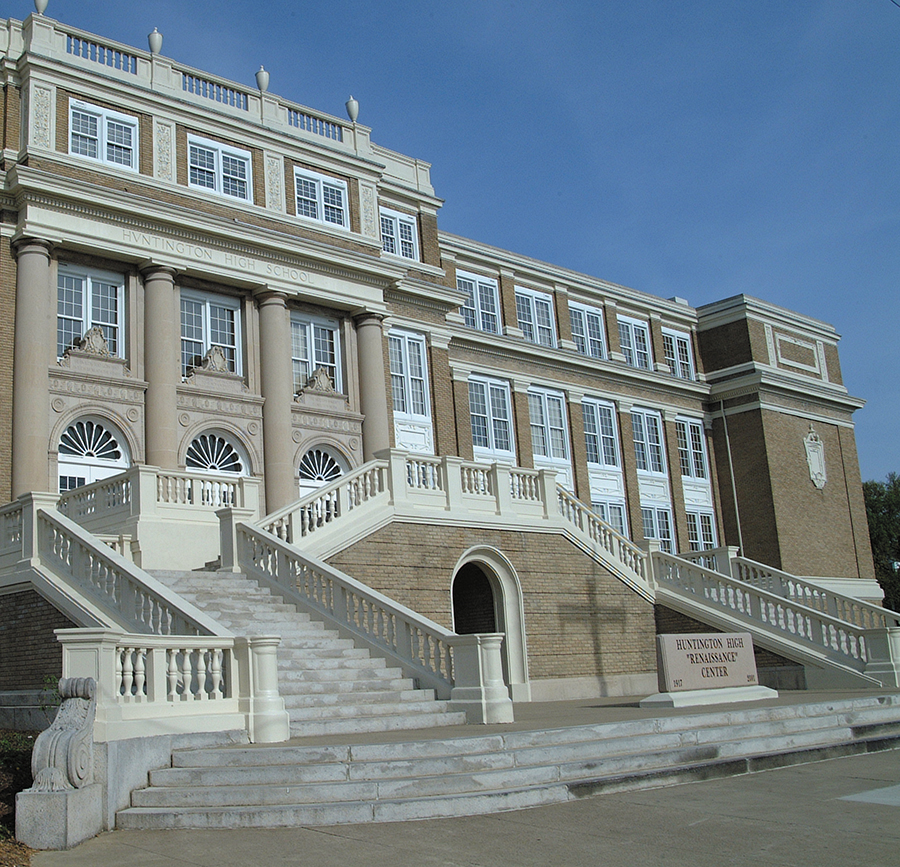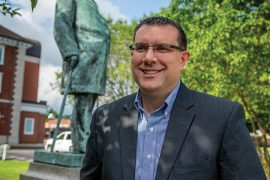The Huntington High Renaissance project has brought together three diverse groups to provide our community with one unique center
By Clint McElroy
HQ 42 | SUMMER/AUTUMN 2001
In the late spring of 1996, classes were dismissed for the last time at Huntington High School. Students slammed their lockers for the last time, teachers walked out the white doors over-looking the double staircase at the Eighth Street entrance for the last time, and the halls echoed with the sounds of life for the last time.
Well, not exactly.
It’s now five years later, and those halls are again echoing with life, although it may not be exactly the same as before.
Many of the voices still have a young timbre to them, but other voices echo as well. Education is still a major component of the life in these halls, but also arts, recreation and the sounds of day-to-day living.
The diversity is a by-product of the unusual cooperative of different groups that have come together to create the Huntington High Renaissance Center. The facility is used by the Huntington YMCA for recreational purposes, by Arts Resources for the Tri-State (ARTS) for the performing arts, and by Huntington Development Corporation for residential use by senior citizens.

Transforming an old, rundown high school into a premiere piece of Huntington real estate was the challenge given to Project Architect Larry Ellis of Huntington. Ellis said he and staff members worked over three years to masterplan and retrofit the 150,000 square foot building into the vibrant facility you see today as you drive though Huntington’s southside.
“My discussions began with Jack Jones at the YMCA and Bill Dotson at the Huntington Development Corporation,” Ellis said. “I assisted in assembling and coordinating local construction teams for apartments and multiple use functions. This undertaking was not only complex, but also required organizational skills that went way beyond the norm of such projects.”
Ellis credits Jones and Dotson for their perseverance and patience.
“They never wavered in their resolve to accomplish their goals. Such innovative owners allow architects to excel in their assignments.”
“I talked to our consultant,” Dotson added, referring to Joe Hogan of Mullin & Lonegan in Pittsburgh. “He said they had done many projects around the country similar to this one, and that this was by far the most complex he’s ever worked on and the most innovative in terms of all the different players.”
Dotson’s group spent an estimated $3.6 million on general construction, turning classrooms into 31 one-bedroom apartments and 11 two-bedroom apartments, which he expects to be at full occupancy by winter.
“These are probably the Cadillac of senior housing,” Dotson speculated. “The space in these units is probably 200 to 300 square feet more than seniors are used to, literally an entire extra room.”
The units are available to seniors, age 62 years and older with an income limit of $12,700 a year for one-person occupancy, or $14,500 a year for two. Surprisingly, Dotson says, there is not much of a waiting list for senior housing at this time, but he predicts a greater need for it in the next 10 to 20 years as the “Baby Boomer” generation reaches its golden years.
The parts of the building being used by the Huntington YMCA are aimed at the earlier years in a person’s life.
“We wanted to bring our youth program into the 21st century,” said YMCA Executive Director Jack Jones. He says he feels the Huntington building has allowed them to do that and much more, when it comes to centralizing programs. “We probably have better facilities than 90 percent of the YMCA’s in the country now.”
This allows the “Y” to improve all their programs and facilities, but Jones and Associate Director George Smailes admit that the main thrust of the Renaissance building has been towards youth. Much like the housing people had to change classrooms into apartments, the YMCA had to turn band rooms and gymnasiums into daycare facilities and areas like “The Adventure Zone.”
The Adventure Zone includes a skateboarding area and indoor ropes course. “We’ve also put in a state-of-the art weight room that is primarily just for the teens and the youth,” Jones commented. They also put in a state-of-the art Fitness Center similar to the center at the YMCA’s 10th Street location.
“We wanted to get the YMCA programs back into a community setting, back into a neighborhood where kids could walk to it, or ride their bikes to it; a place where parents would be comfortable dropping their kids off,” said Jones. “This facility accomplishes that.”
There is a third component to this interesting mix, a component not dedicated to serving any specific age group, but with a performing arts spin.

Arts Resources for the Tri-State (ARTS) was formed in April 1998, and made up primarily of three organizations: Tri-State Youth Orchestra, Huntington Outdoor Theatre and Musical Arts Guild along with the committee of Musical Arts Guild Children’s Theatre. The purpose of the “umbrella organization” is to promote and facilitate performing and fine arts in the Tri State region through education and enrichment.
Rosa Lee Vitez of ARTS says the organization sees itself serving as a production company and facility manager for the auditorium and related space. She says a great deal of work has already been done on cleaning and renovating the auditorium and rooms like the former library, which is used extensively as a rehearsal area. Like the other two “partners” in this three part project, ARTS also finds itself faced with the task of expensive work ahead, especially involving sound and light systems for the auditorium.
In May, Estella Walton Whitehead was named the director for ARTS. This is a lady who knows her way around performing arts on both sides of the curtain. Whitehead is an accomplished jazz vocalist who has also worked in arts relations all across the country. The performance connection also stretches to her home – her husband is Marshall University’s Director of Bands and Music, Baruch Whitehead.
The group is actively pursuing grants and working on many fund-raising projects. Two major fund-raisers utilized the talents of former Huntington residents who have gone on to make quite a mark in the entertainment realm – brother and sister J. Mark McVey and Beth McVey Adams.
Mark recently concluded a critically acclaimed run as Jean Valjean in “Les Miserables” on Broadway, a role that garnered him international acclaim. He has made numerous appearances on the Great White Way in hits such as “The Who’s Tommy” and “The Best Little Whorehouse Goes Public.”
Beth, a former Miss West Virginia, played Mrs. Potts in the original Broadway cast of “Beauty and the Beast” along with Broadway performances in “42nd Street,” “Phantom of the Opera,” and “Nine.” She has toured nationally with “Guys and Dolls” and recently concluded a tour of “Barry Manilow’s Copacabana.”
As if that weren’t enough star power, Mark’s wife Christy Tarr McVey joined the brother and sister performing in two galas at the auditorium. Christy made her Broadway debut in “The Who’s Tommy” (where she first met Mark), then toured with the show. She also had Broadway credits in “Jekyll and Hyde” and “Annie – The 20th Anniversary Tour.” Another McVey made her stage debut during the most recent gala: Mark and Christy’s baby daughter, Grace.
“We all wanted to be involved with the Huntington High Renaissance project due to the potentially multi-faceted cultural good that can come to the entire community,” says Mark, who called the project “the opportunity to help strengthen and enhance the cultural climate of the area which we are still proud to call home.”

“Multi-faceted” is a good word to describe the entire Huntington High Renaissance project. Bringing it about has been possible only through what Dotson calls a series of “complicated collaborations.”
One concern was the complications that might arise from having a facility that was a residential area and performance venue at the same time. “The only thing that we anticipated was that on production nights there might be a lot of people in the building,” says Dotson.
The most recent ARTS fund- raising gala gave him a chance to look into that. After the event, Dotson asked residents if they were able to hear any of the commotion in the hallways during the sold-out gala. The answer was “no.”
“Our suspicions were bore out that when you are in your apartment, you are not going to be bothered by a thousand people milling around.”
Over the last few years, most of those people milling around the old Huntington High School building were working on construction, relocating sets, costumes, props and other equipment into the many rooms. That kind of work may have slowed, but isn’t finished by any stretch of the imagination.
Those associated with this “complicated collaboration” realize this project is an on-going one. And there is a precedent – the Italian Renaissance began early in the 14th Century and lasted well into the 16th Century. The groups involved in this Renaissance certainly hope it doesn’t take quite that long to get where they want to be.
But the historical model of this historical era, which saw significant improvements in the arts, housing and lifestyles, is a perfect model for Huntington to emulate.





